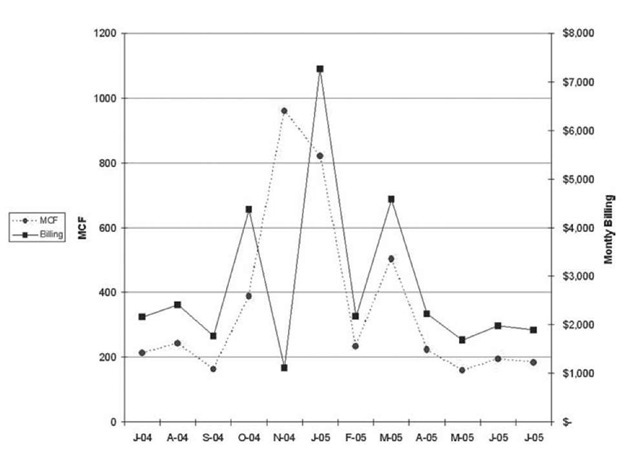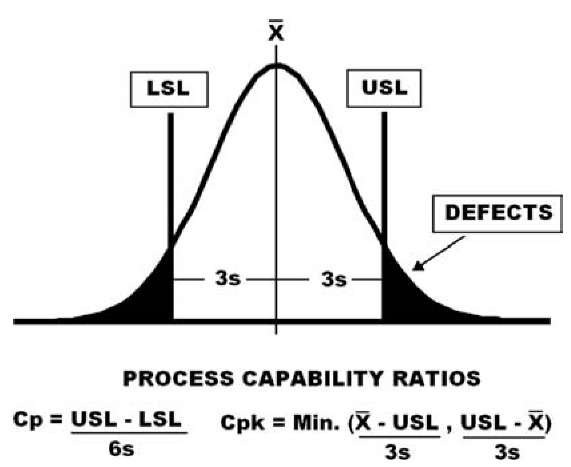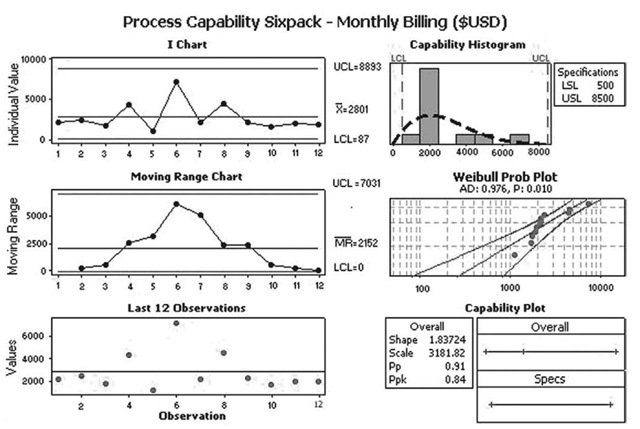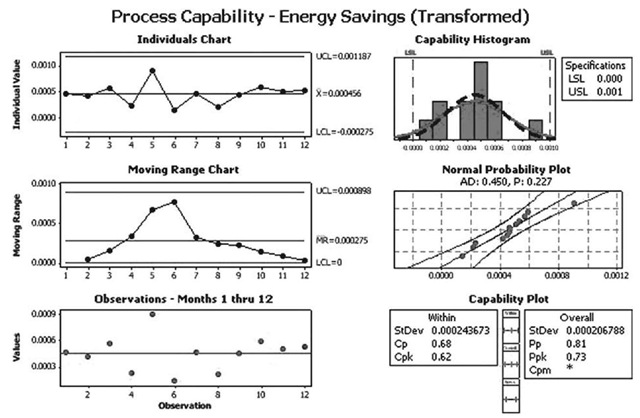Abstract
“If you can’t measure, you can’t control—if you can’t control, you can’t manage—if you can’t manage, you can’t contain costs.” As a process-oriented activity, energy management begins with a thorough assessment of use and culminates in the implementation of an effective energy management plan. Applying the five process improvement steps of a Six Sigma DMAIC (Define, Measure, Analyze, Improve, and Control) activity provides a way to define, measure, analyze, improve, control, and verify energy use and savings. The straightforward approach of this process provides a cost-effective means of optimizing facility energy and cost efficiencies.
These efficiencies are transformed into energy savings based on improvements to both facility process and utility-related activities, with process-related activities encompassing all product manufacturing events, and utility-related activities including automated building systems and all other activities not directly related to manufacturing events.
The DMAIC process for each begins with a well-defined problem statement that is supported by examination of existing data to formulate the project premise. Combining “tribal knowledge” with sound data analysis highlights the pathway to process improvement and long-term savings.
NOMENCLATURE
DMAIC Acronym for Define, Measure, Analyze, Improve, and Control, a five-phase, Six Sigma project-focused approach to continuous process improvement
Tribal knowledge Tacit knowledge held by individuals or groups based upon their individual and collective experiences Stage gates A management review of the process used to screen and pass projects as they progress through their various stages of development ROI Return on investment = net income/investment, where net income = expected earnings MSCF Million standard cubic feet Energy audit A systematic survey conducted to measure and record energy consumption, used to identify opportunities to reduce energy use and cost of a specified process or experiment Correlation coefficient r; statistic that describes the strength of a relationship between two variables Coefficient of determination r2; the square of the correlation coefficient, and a measure of the strength of the association between two variables p-value Probability value; a number that reflects the probability that a statistical result happened by chance, causing a hypothesis to be either accepted or rejected KPIV Acronym for Key Process Input Variable KPOV Acronym for Key Process Output Variable Control plan A document that ensures processes are operated and monitored consistently so that the desired result meets the defined requirements Cp Process capability; represents the spread of the process. A Cp Value of 2 is representative of a 6cr process (0.002% rejects) Cpk Process capability of non-centered process; is an indication of how the process is aligned to the process mean. Cp and Cpk are equal in a centered process
Process capability ratios Capability indices used to measure short-term and long-term process standard deviation Special-cause variation The rate or magnitude of change in an output resulting from an unexpected event Common-cause variation The rate or magnitude of change in an output resulting from expected or everyday events Run chart A graphical display of data representing process outputs over a given period of time, used to determine stability of a process Process variation The quantifiable difference between individual measurements, represented in a designed sequence of operations or events DPMO Acronym for defects per million opportunities Project charter A formal document that defines the mission of the project, project scope, financial benefit, measurement metrics, time frame and resource requirements As-is process map The current flow of events in a process containing the inputs and outputs of each process step Capability analysis A measure of how a process is performing, visually represented in terms of a bell-shaped curve, in terms of how much variation exists in the process and how centered it is within the limits of the process
Cause-and-effect matrix A chart used to rank the relationship between process inputs and outputs of a designed sequence of operations or events Failure modes and effects analysis FMEA; a document that provides a systematic technique to identify and analyze potential failure modes by quantifying them according to the severity of risk they present
Risk priority number RPN; a numerical indicator used to identify the severity of risk Measurement system analysis MSA; an evaluation used to determine the precision of a given response
Graphical analysis An investigation of how a process or event is performing by representing the data in diagram form Hypothesis test A statistical method to determine if there are differences between two or more process outputs
Regression analysis A statistical technique used to investigate and model the relationship between dependant and independent variables Cost-benefit analysis A technique used to analyze competing alternatives based upon comparison of total cost to total return Predictor variable A value that can be used to predict the value of another variable Response variable A value that represents the outcome
INTRODUCTION
We live and work in an ever-increasingly volatile and complex business environment that has begun to recognize energy use and efficiency as strategic elements of our overall business planning process. Under deregulation, energy providers pass on a higher percentage of energy cost increases to the consumer in the form of cost adjustment factors. These added costs, the efficiencies of the energy conversion processes we employ, and environmental effects are what Six Sigma practitioners would define as critical inputs (X-values). Outcomes—or 7-values—are a function of these critical inputs and stated in terms of our monthly utility expense. By applying Six Sigma methodology to the issue, we are able to define energy use as a process and employ a useful set of metrics to measure, improve, and control variation in our monthly utility bills.
ENERGY MANAGEMENT—PURPOSE AND GOALS
The goal of energy management planning is to optimize both the consumption energy and its cost. This article offers an overview on how to apply Six Sigma methodology to continuously improve energy consumption processes using DMAIC principles. Six Sigma methodology also benefits energy managers by adding stage-gate approvals into the energy management plan development process.
SIX SIGMA—BACKGROUND
Established in the 1980s at Motorola and brought into mainstream use by GE in the mid-1990s, Six Sigma employs data-based decisions built around baseline measurements to reduce waste and process variation. This fundamental objective is often achieved using the five-step DMAIC process (Define, Measure, Analyze, Improve, and Control). Since most energy use projects are site specific, this article will serve to guide users in the application of Six Sigma methodology rather than developing a specific case study. Additionally, sample sets of data have been employed to simplify data analysis while offering an acceptable level of confidence in the results.
FINANCIAL CONSIDERATIONS AND INCENTIVES
Capital expenditures for facility energy infrastructure projects are rated based upon financial criteria that seek to establish their expected rate of return. While financial analysis of large energy infrastructure projects is often complex, smaller straightforward projects generally stress the expected return on investment (ROI). This article employs ROI Analysis to forecast the expected rate of return.
Fig. 1 Energy usage.
It should be noted that the Energy Policy Act of 2005 provides substantial tax incentives to encourage improving energy efficiency in both new and existing buildings. A major aspect of the act is the ability of facility managers to obtain new energy equipment and apply any derived cost savings to energy utilization.
DATA SOURCE
Research data used in this article were obtained from the monthly service billings of a small aftermarket repair facility in Houston, TX., that employs a single analog utility meter to record energy consumption (Fig. 1). This facility was selected based upon the simplicity of its metering scheme and the ability to readily obtain a sample set of data that fit the reporting purposes of this article. Larger facilities will employ sub-metering or data-recording devices that allow users to categorize energy use by process segment. The ability to link energy use to individual machine tools or processes enhances the ability to analyze data and verify the impact of specific improvements.
In practice, one of the first steps taken in evaluating energy use is an energy audit. Usage data are gathered from a variety of sources including metering devices, sensors, and utility bills, and combined with maintenance information to identify energy cost reduction opportunities. Self-assessment and assessments conducted by university-based industrial assessment centers are two low-cost means of performing an energy audit.
SETTING ENERGY CONSUMPTION TARGETS
Determining the need for improvement requires establishing current usage (baseline) data that can then be compared with desired objectives or best industry practices. Performance against the desired outcome can then be measured in terms of its process capability ratios (Cp and Cpk).
SIX SIGMA—THE DMAIC PERSPECTIVE
Overview
As a rigorous methodology that uses data-based decisions and statistical process control, Six Sigma provides firms with a robust platform to minimize variability, defects, and waste in the processes we employ to convert goods and services into revenues. In practice, Six Sigma represents how well a process is performing and how often a defect is likely to occur—the higher the sigma value, the better the process is performing.
Since energy savings programs are essentially project activities, we can readily apply DMAIC methodology to characterize and optimize desired benefits. The five phases of this process are as follows:
• Define—Stating the desired need in the form of a problem statement.
• Measure—Determining the baseline and target performance values.
• Analyze—Relating process inputs (critical X’s) to process outputs (Fs).
Fig. 2 Process capability.
• Improve—Identifying improvements to optimize outputs.
• Control—Establishing control procedures and accountability.
Variation and Mean Shift
Every process includes both common-cause variation and special-cause variation. Common-cause variation occurs naturally in any process, while special-cause variation is nonrandom and the result of an action or a series of actions. Process improvement seeks to reduce special-cause variation, shifting the mean to center and stabilizing the process (Fig. 2). The capability of the process to consistently perform within specification limits relies on achieving both. A common tool employed to display both stability and variation is the run chart, which allows users to quickly gauge the amount of variation in a process. Points outside the process upper and lower limits, unequal dispersions around the mean, and pattern variations are all indicators of a process variation requiring further investigation.
Defect Prevention
A process, product, or result may contain a single or multiple number of defects before it is considered defective or out of specification. Defect prevention results from error proofing the activity. The common defect measure is expressed in terms of parts per million or defects per million opportunities (Table 1). A process operating at Six Sigma levels produces no more than 3.4 defects per million operations, meaning that the process is operating at a 99.99966% defect free rate. For energy savings projects, a defect may represent any point outside of the run chart control limits.
Data-Based Decisions
Six Sigma converts data into useful information that allows users to base their decisions on facts rather than opinion. Data-based solutions may result in improvements that match expert opinion, but data-driven solutions coupled with statistical process control remove errors while adding process control capability—all resulting in higher probability of a successful outcome.
DMAIC METHODOLOGY
Define
During this initial project phase, the problem statement is created in the form of a project charter. Project charters establish the project’s scope and improvement objective; detail the financial impact of the project in a business case; and forecast the project’s expense, savings, and required resources.
Measure
Understanding the Process
Before a process can be improved, it must first be measured to establish a baseline for comparison and targeted improvement objectives. Baseline data (typically in kilowatt-hours or million standard cubic feet) may come from utility bills, meter readings, or data recording devices. Following data collection, key process variables are identified by creating a top level as-is process flow to help narrow the focus of the improvement effort to those key process steps having the highest levels of special cause variation.
Process Capability
The demonstration of process performance is accomplished through capability analysis, by comparing the width of the process variation to the width of the acceptable process tolerance limits, or by measuring the defects present in the existing process. The standard measures of capability are defects per million opportunities (DPMO) and process capability ratios (Cp and Cpk).
Table 1 Defects per million opportunities yield and Sigma
| Sigma (cr) value | Accuracy
(%) |
Defects per million opportunities (DPMO) |
| 1 | 30.85 | 691,500 |
| 2 | 69.15 | 308,500 |
| 3 | 93.32 | 66,800 |
| 4 | 99.38 | 6,210 |
| 5 | 99.977 | 233 |
| 6 | 99.999 | 3.4 |
Fig. 3 Energy usage process capability.
Analyze
Non-Normal Data
Before performing any data analysis, one should check data for normality, since standard capability indices contain an assumption of normality. With energy usage programs, data is likely to be non-normal due to a number of factors including monthly utility fees and surcharges. The data used in this article is non-normal data that was transformed before use (Fig. 3).
One strategy is to make non-normal data resemble normal data by using a Box-Cox transformation function to convert the data closer to a normal distribution (Fig. 4). The underlying technique of the Box-Cox transformation is based on developing a normality plot using the correlation coefficients for the defined transformation parameter (A, the lambda value). The relatively high p-value taken from the fitted line plot on Fig. 4 indicates that the transformed data is normal and capable of being analyzed using Six Sigma statistical tools. The capability charts indicate that significant variation occurred between periods 3 and 10, signifying that further investigation of these eight time periods is required. These periods should be analyzed with reference to the process step inputs and outputs developed in the as-is process map to identify any observable key input or output variables.
Sources of Variation
Once as-is process capability is defined, it is necessary to understand cause and effect relationships. A cause-and-effect matrix is the tool used to rank relationships between the key input and output variables. When complete, the cause-and-effect matrix is linked to a failure modes and effect analysis (FMEA) by transferring the highest-ranked input variable or variables onto the FMEA. This analysis is used to identify and force rank by criticality, the potential failure modes, and their effects and causes, using a risk priority number (RPN). Only the highest-rated factors qualify for investigation.
Fig. 4 Energy usage process capability transformed.
Measurement Error
Accuracy of the measurement system can be the predominant reason for process variation. Employing measurement system analysis (MSA) will allow the firm to evaluate the accuracy and precision of the measurement system. Where measurement systems are inadequate, it is recommended that they be upgraded to a level consistent with the project requirements.
Corrective Actions
Completion of the FMEA requires statement of the corrective action needed for process improvement. For each action taken, it is necessary to recalculate the RPN to validate process improvement. A variety of Six Sigma statistical tools are available to confirm the impact of the corrective actions, including graphical analysis, hypothesis testing, and regression analysis. As a supplement to the FMEA, a cost-benefit analysis should be developed to define the optimal level of planned investment.
IMPROVE
Improvement seeks to optimize outputs (Ps), eliminate or minimize defects and variation, and statistically validate new process operating conditions.
Variable Relationships
The governing principle behind variable relationships is expressed in terms of y = /(x), wherein key output (y) is stated as a function (f) of the key inputs (x). A common statistical tool used to examine this relationship is regression analysis, which correlates the degree of association between the predictor variable (x) and the response variable (y) in terms of r, the correlation coefficient. Where r> 0.8 or < — 0.8, a significant relationship exists; for values between — 0.8 and 0.8, no significant relationship exists. The amount of variation in the output that is explained by the regression model is R2, the coefficient of determination. In terms of energy analysis, a strong correlation indicates that the output (y) or energy use is defined by the input values (x) being modeled. The final term dealing with correlation in the regression is the p-value, which indicates whether there is a correlation between the variables. A p-value can also be used to determine normality, which can be seen by the fit of the variables to a fitted line plot (Fig. 3).
For the facility cited in this article, it was determined that utility fees and surcharges were the critical inputs. Regression analysis indicated a weak correlation to the various input factors of shop load, utilization factors, maintenance, and seasonality, due in part to the limited amount of data and unpredictable increases in utility energy fees and surcharges. Based upon the age of the facility and a cost-benefit analysis of the upgrades needed to operate the facility at optimal energy levels, it was determined that the best alternative was to switch to a lower-cost energy provider as the means to reduce energy costs.
New Process Capability
Following implementation of the recommended actions, it is necessary to establish the new relationships of key process input variables (KPIVs) and key process output variables (KPOVs) by running a second capability analysis using data from the improved process. This information is then compared to the original baseline data to establish the level of improvement obtained. The final steps in defining the new process capability require updating the process map to reflect implemented changes and validating project cost savings.
CONTROL
The final project phase documents, sets up control criteria and assigns accountability for sustaining the gains achieved through process improvement. Control plans are intended to permit operating processes consistently on target with minimum variation by defining and monitoring critical success factors (KPIVs and KPOVs); as well as the employed measurement methods, frequency, and decision rules governing corrective action. It is important to remember that the control plan is a living document and part of a continuous process improvement activity.
CONCLUSION
The primary advantage of Six Sigma as a continuous process improvement tool, is its ability to provide a set of metrics that can then be used to understand and correct process variation. Six Sigma is a project-focused activity that adapts well to time-dependent activities. The five-phase DMAIC model is commonly applied to characterize and optimize industrial processes. Understanding how energy is consumed in the processes we employ requires that we first establish a method of measurement to identify how energy is being consumed and in what quantities. Organizing data into useful information is accomplished in the measurement phase of the DMAIC process, which establishes the baseline against which all future improvements will be compared. What prevents decline of the improved process is the control plan, which is established to identify ongoing surveillance requirements and corrective action plans.




